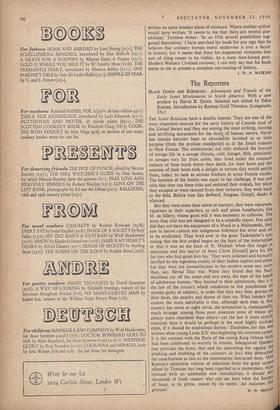Religio Historici
AN HISTORIAN'S APPROACH TO RELIGION. By Arnold Toynbee. (O.U.P., 21s.) REVIEWS of Professor Toynbee's new book have been polite but reserved. Its religious motive is heartfelt but the consum mation it seeks—a single world religion which combines the timeless essentials of the 'seven higher religions' and discards * THE VANISHING HERO. (Eyre and Spottiswoode. 21,4.)
their accidental accretions of time and place—has been given a
cool reception. Christian reviewers have mildly pointed out that at least one time and one place are essential to Christianity. It
May be added that the idea of examining all religions to find their common core around which deists of the world can unite Was a favourite enterprise, which repeatedly misfired, during the seventeenth century, the century to which Toynbee attributes most of our present ills.
Reviewers have not said much about the way Toynbee uses history for his religious purpose in this book. At the risk of being a bore I want to raise the hoary question of his historical method once more. He states that there are only four views of history. The first three are : the 'Indo-Hellenic' idea of a cyclical move- ment governed by impersonal laws; the ludreo-Zoroastrian' idea of a vast unrepetitive drama, the unfolding of a cosmic plot; and the 'Chinese' idea of 'a series of variations on a theme enunciated at the start.' Since, on all these three views, human actions merely illustrate some pattern which they cannot dislodge, it is clear that the remaining view should be the view that history is simply the outcome of the moral and immoral ideas, ambitions, policies,
hopes and fears, and downright hard work of human beings.
The outcome may not reflect the intention of any one person or group, because of inertia and rivalry; but even where no one Policy succeeds, the outcome need not be chaotic. As so many economists and anthropologists and Whig historians have insisted, the competing activities of various men often produce some stable and orderly but unintended result.
Considerations like these have been addressed to Toynbee by humanist philosophers of history again and again. But he remains blandly impervious to criticism. The only alternative he can see to his three superhuman views of history is the 'antinomian Late Modern Western' view of history 'as a chaotic, disorderly, for- tuitous flux.' This view, needless to add, he contemptuously dismisses.
Toynbee takes the human significance out of history and injects a bogus cosmic significance into it instead. He finds people
and institutions interesting, never in themselves, but only as illustrations of some wearisome 'pattern.' He treats the historical
Products of human toil, imagination, cunning and suffering as
so many bright beads which need to be selected and strung together according to some recipe of his own. This makes his historical
narrative extraordinarily flat and lifeless, often little more than a string of names and nouns spelt with capital letters. Here is a representative passage :
The North European barbarian successor-states of the Roman Empire had been more incompetent than its Arab successor-state and than the Eurasian Nomad successor-states of the Chinese Empire; and thereafter the attempt to revive the Roman Empire had been a fiasco in Western Christendom, whereas it had been a success in Eastern Orthodox Christendom, as the corresponding attempt to revive the Chinese Empire had been in Eastern Asia.
The historian ordinarily regards it as a part of his job to pick out the peculiarities which give historical happenings their special flavour. Toynbee's method is to carve up history into a few vast and heterogeneous units and to blot out their vital internal dtffeCences. (Thus he generalises about 'the whole Judaic group of ideologies and religions,' a group which contains Judaism, Com-
munism, Liberalism, Christianity and Islam.) Having marked out these great chunks of history Toynbee moves freely around in time and space collecting scraps of evidence to confirm his generalisations about them. This method allows him to 'prove'
anything. Much of the book is devoted to two contentions: first, that man is a sinful and divided creature; second, that in the seventeenth century the worship of God gave place to the worship 0,,f technology. In confirmation of the first contention he quotes from such seventeenth-century religious thinkers as Pascal and Sir Thomas Brciwne; in confirmation of the second, from the seven- teenth-century historian of the Royal Society, Thomas Sprat, a disciple of Bacon. Had he wished to confirm the opposite conten- tions that man's nature is full of boundless possibilities and that
the seventeenth century was a deeply religious age, he need have One little more than transpose his quotations. Toynbee conveys the impression that his book has got itself
written on some timeless plane of existence. Where another author would have written, 'It seems to me that there are several pos- sibilities,' Toynbee writes: 'In AD 1956 several possibilities sug- gested themselves.' I have searched his boqk for any sign that he believes that ordinary human moral endeavour is ever a factor in history; but it seems that from his magisterial viewpoint that sort of thing ceases to be visible. As a mere time-bound post- Modern Western Civilised reviewer, I can only say that his book seems to me to present a complete mis-reading of history.
J. W. N. WATKINS












































































 Previous page
Previous page